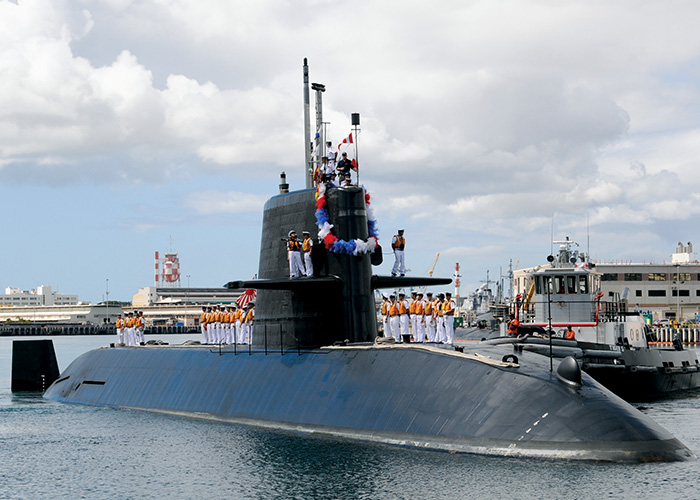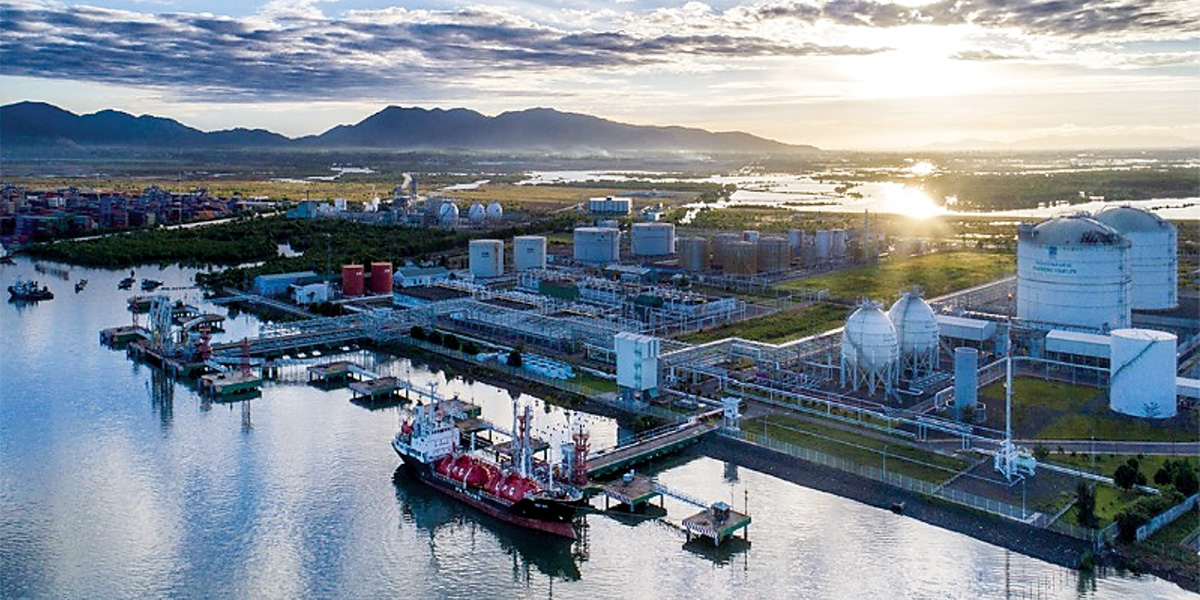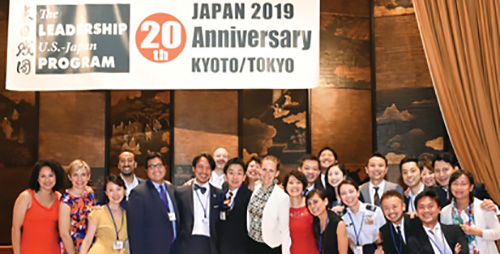A Partnership-Centered Approach to the Indo-Pacific
To maintain peace and prosperity in the trans-Pacific and beyond, the United States should rely on a proven strength.
BY JONATHAN AHLSTROM

Japanese submarine JS Mochishio arrives at Joint Base Pearl Harbor–Hickam in October 2011 to support a multinational naval exercise designed to strengthen regional partnerships and improve multinational interoperability.
U.S. Navy / Ronald Gutridge
Nestled in a corner of the joint Naval and Air Force base on the Hawaiian island of Oahu, a small restaurant overlooks the turquoise channel of water as it makes its final push from Pearl Harbor to the Pacific Ocean. From there, one often sees the silhouette of a submarine gliding peacefully through the water—a small intrusion on the calm surface. One day, on one submarine, however, the flag flying proudly on the sail does not show the stars and stripes, but instead a single red circle resting on a white backdrop—a rising sun.
The gravity of the moment might initially escape an observer as the submarine sails past the memorialized site of the battleship USS Arizona, whose sailors remain forever entombed in their watery grave following the devastating Japanese attack on Pearl Harbor in December 1941. An observer might not understand the significance of the submarine sailing on past the looming silhouette of the battleship USS Missouri, whose decks served as a backdrop to Japan’s unconditional surrender after the destruction of Hiroshima and Nagasaki in August 1945.
Looking closer, one would see the single most powerful aspect of the entire event: An American and a Japanese naval officer, once mortal enemies, sit beside each other on the submarine’s sail, smiling, talking and exchanging stories as they head out for regular joint undersea operations to ensure peace and prosperity in the western Pacific.
The Japanese American story captures the essence of one of the United States’ greatest strategic advantages: the ability to build enduring partnerships with other countries. This ability is extremely important today in the context of rivalry with China, a growing great power that is capable of shifting the balance of power in the Indo-Pacific region in its favor.
Though we are far from the days of the Chinese emperors, China’s approach to partnership-building maintains an element of cultivating vassals, not partners. This approach misses the connective tissue that forms between nations working toward shared common interests, and often employs leverage rather than constructing relationships of mutual respect that celebrate religious, cultural and institutional differences.
To capitalize on its advantages in building enduring partnerships, the United States must intensify efforts to bring allies together to maintain global peace and prosperity in the trans-Pacific region and beyond. Genuine partnerships are a force multiplier and can directly serve American strategic interests and initiatives at home and abroad.
Understanding the U.S.-China Rivalry
For the United States to engage in serious conversations with international partners on the challenges of the Sino-American relationship in the trans-Pacific region, it is important to enumerate a set of initial suppositions, some of which might be hard for Americans to accept at first.
First, rivalry with China is not all bad. The United States’ response to the rivalry is what matters. Historically, rivalry has brought out America’s competitive spirit. A rivalry forces Americans to be better, not repose in complacency and, above all, do what America does best—innovate. A rivalry today must see American innovation increase to the pace necessary to face tomorrow’s global challenges.
Second, the rise of China reveals weaknesses in U.S. foreign policy, foreign development efforts and the military. American efforts abroad have real weaknesses and inconsistencies. Failing to identify these weaknesses can have serious consequences. It is how the United States responds to these challenges that matters.
Third, the Sino-American relationship is complex. Although ideological differences exist, the Sino-American rivalry is a very different competition from the Cold War. China is integrated into the world economy and has a different demographic profile, geography and culture, and a much larger economy relative to ours than did Soviet Russia. In addition to the deep economic ties between the United States and China, more than 350,000 Chinese students were studying at American institutions during the 2019-2020 academic year. The United States must assume and appreciate that similar complexities exist between other nations and China. American policymakers need to make tough choices, but posing binary choices in many instances will prove insufficient to ensure a peaceful and prosperous Indo-Pacific.
Fourth, how the United States conducts itself in this era of great power rivalry matters. Although taking the high road is that much harder when the competitor takes the low road, it is still the right thing to do. China’s treatment of the minority Muslim population of Uighurs in the Xinjiang region, where millions are imprisoned and mosques are systematically destroyed, is an example of taking the low road. The United States’ employment of “enhanced interrogation” techniques, a euphemism for torture, following the Sept. 11, 2001, attacks is another—and it has proved costly in light of America’s professed interest in promoting democratic society, human rights, freedom from oppression and economic prosperity. The concession of values inevitably yields a much deeper negative consequence than the perceived immediate gains.
Finally, this is not a war, a competition or a rivalry that America can “win” in the traditional sense. History shows that declaring victory in a competition that one can never truly win achieves only short-term gain, proving detrimental over time. If U.S. strategy in the Indo-Pacific region is solely driven by the need to “win,” then we have chosen a path that assures defeat.

In October 2019, PetroVietnam Gas began construction on the Thi Vai LNG terminal, Vietnam’s first large-scale liquefied natural gas facility and an important strategic step toward energy security in Vietnam. The facility is projected to come online in late 2022.
from Thailand Construction News
Three Additional Domains for Partnership-Building
In light of the challenges China poses to the United States today, the conversation tends to concentrate overmuch on the military component of partnerships. Military capabilities represent an indispensable factor in the trans-Pacific equation; however, a partnership is much more than security assistance or military spending. To build cohesive partnerships that effectively balance the challenges posed by China to the liberal world order, the United States should, at a minimum, address three additional domains.
Energy. First, as the world rallies around the need to respond to the real challenges of climate change, the United States must focus on energy sector development with partner countries. Governments and international providers are putting in place strategies to lead away from carbon-based fuels. China’s Belt and Road Initiative, a global infrastructure development strategy, brings the promise of energy, but often with significant costs to a country’s autonomy and independence. The United States is well positioned to be a leader in the energy development field, and the Department of State and U.S. Agency for International Development are already leading international energy initiatives. The United States can bring to bear a holistic government approach to partnership-building that capitalizes on the expertise of the Development Finance Cooperation, Export-Import Bank, Department of Energy, and so on. Partners should establish a focused agenda to cover energy sector diversification, private-sector investment, sustainable energy development and energy security.
The Japan-U.S. Strategic Energy Partnership (JUSEP) is a model of effective collaboration in this area. A joint effort committed to growing sustainable and secure energy markets across the globe, this interagency program facilitates close coordination between the development and finance arms of each government to offer workable solutions to countries in need. Most recently, under the umbrella of JUSEP, new levels of cooperation in liquefied natural gas (LNG) and renewable energy development in Vietnam have been achieved. These efforts are in line with the ongoing commitment from both countries to collaborate on developing the energy sector of the lower Mekong River.
The digital economy. Second, although the United States recognizes the digital economy is growing rapidly around the world, it should employ a tailored approach to partnership-building in this domain. China today represents more than 40 percent of the global digital and e-commerce transactions and continues to expand its share. Beijing expends significant effort and treasure in extending its digital influence through key positions on international governance boards, fast-paced rollout of 5G infrastructure and technology, and initiatives under the umbrella of the Digital Silk Road. China employs extreme cross-border data flow restrictions, and valid international concerns exist over fair competition and access to intellectual property rights for companies operating in the Chinese sector or through Digital Silk Road projects.
As in the energy sector, it is important to recognize that countries are at different stages of digital sophistication. It is imperative for the United States to work with partners to advocate an open and transparent digital economy in developed and developing countries. A comprehensive strategy must seek to grow infrastructure and guide regulation development. The Standards Alliance, a public-private partnership between the U.S. Agency for International Development and the American Standards Institute, is an effective existing platform to engage partners further on this. The partnership focuses on capacity-building assistance in developing countries and allows for joint work with international partners to this end. Through this approach, partner countries are more likely to reject state control, invasive monitoring and direct interference in the development of their digital economies.
Exchanges. Third, the United States must seriously commit to the need for cultural, educational and people-to-people exchanges called for in its National Security Strategy. The United States is globally recognized as a leader in education, leadership development and youth exchanges. However, resting on one’s laurels is not sufficient in today’s challenging environment. As China’s Confucius Institutes multiply and promote youth education and cultural exchange programs, it is time for the United States to re-recognize the long-term strategic benefits of such programs. Former Japanese Prime Minister Shinzo Abe’s strong connection to the United States undoubtedly has its roots in his time as a student at the University of Southern California. However, today Japanese students more often search for opportunities to study in China than they do in the United States.
Understanding the culture and motivations of our partners is as important as understanding those of our potential adversaries. Few historical examples of failed understanding are more tragic than the lessons of the Vietnam War—two, in particular. First, the United States underestimated the nationalism that primarily motivated the North Vietnamese. Second, as former Defense Secretary Robert S. McNamara acknowledged in his 1996 memoir, In Retrospect, the United States failed to understand South Vietnamese leaders because we viewed the problem only through the lens of American experience.
Opportunities, Not Burdens

In September 2019, delegates of the U.S.-Japan Leadership Program gathered in Tokyo in celebration of the 20th anniversary of the program’s founding. The program annually selects young leaders from both countries to collaborate, learn from each other, and establish a lasting network of friendship and understanding.
USJLP
The United States cannot afford to view alliances as burdens, but rather as opportunities in which to invest. In the world of finance, the traditional mutual fund finds its greatest value through diversification—creating resilience to the swings of the market. A coalition of partners, each contributing unique value to the greater cause, operates similarly. As with an investment, the quality of the portfolio matters: Capable and reliable allies are the bedrock of the mutual fund.
Along the same lines, good partnerships are also force multipliers. For example, a strong bilateral relationship with Japan helps improve U.S. relations with Vietnam, providing new avenues of approach to growing this less-robust partnership. Because Japan is one of Vietnam’s most significant foreign aid donors, a strong U.S.-Japan relationship opens doors for joint endeavors in critical areas such as energy infrastructure development or rare earth metal cultivation. In the face of Beijing’s encroachment and territorial claims in the South China Sea, Japan and Vietnam operate together under a bilateral defense arrangement. This, in turn, offers the opportunity for improved defense arrangements with the United States.
Finally, the United States should view the challenges presented by China as more than a trans-Pacific matter. The United States must reinvest in renewing strained relationships with our trans-Atlantic allies and partners, as well. As a new generation of leaders ascend to senior positions in American government, none wear the scars of total world war, few have grappled with the faraway horrors of the Vietnam War and only a minority grasp the depth of tensions of the Cold War. This is not to say that today’s generations are without scars. However, the lessons of the past that formed the foundations of our existing democracy, international organizations and the liberal world order are fading from memory.
Although burden-sharing is an important element of traditional defense agreements, the discord surrounding defense spending must not overshadow the importance of growing, and in some cases renewing, cross-domain cooperation with both new and long-standing allies. To gain momentum in the Indo-Pacific region, the United States must build on its record of success and engage in a whole-of-government approach to partnership-building with other responsible members of the international community.
Read More...
- “Secretary Antony J. Blinken Remarks at Top of Meeting with the Foreign Ministers of the ASEAN Nations,” State Department, September 23, 2021
- “Strategic Partnership or Strategic Dependence?” by Jon Ahlstrom, Proceedings, September 2019
- “Is American Diplomacy with China Dead?” by Susan A. Thornton, The Foreign Service Journal, July-August 2019



